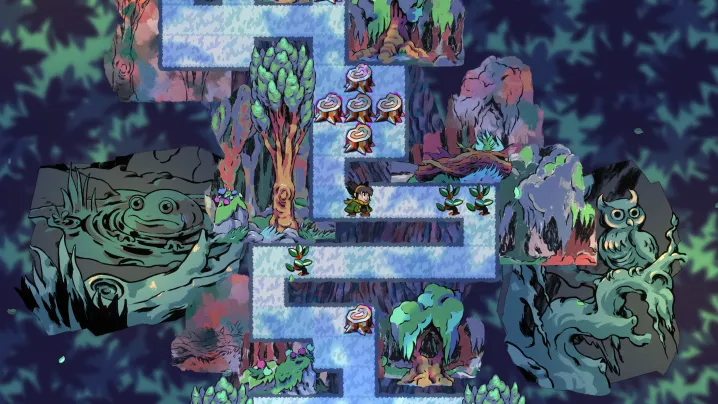This year may be over, but 2024 has one more major video game sequel left in the tank. On December 10, Ustwo Games will release Monument Valley 3 on mobile devices. It’s the third installment of a series that helped define mobile gaming a decade ago. To make matters even sweeter? It’s being distributed by Netflix Games, which means that anyone with a subscription to the service will have access to it at launch without spending an extra penny.
So where’s the fanfare?
Monument Valley 3, another mesmerizing puzzler that’s custom-made for small touchscreens, is the latest high-quality mobile release of 2024 that feels destined to slip under the radar. It closes out an odd year for services like Netflix and Apple Arcade, both of which have long struggled to be treated like top-tier gaming subscription services despite their increasing hit rates. It’s a sign of just how challenging the mobile market can be, even when companies deliver the exact kinds of games players say they want.
A lovely threequel
Monument Valley 3 doesn’t change its predecessors’ formula that much, but it doesn’t need to. The first Monument Valley was a hit for a reason, as it gave players a soothing puzzle game filled with mind-bending imagery. It wasn’t too difficult and its tactile touch controls made it a must-download at the time. In a market where phone games were seen as hollow time wasters or money traps, Monument Valley showed how a small-scale game could be visually inventive, emotional, and satisfying without preying on players’ time or wallets.
The latest game continues that trend. This time, players control a lighthouse keeper, Noor, who is tasked with restoring the structure’s light to fend off a growing climate crisis. The basic puzzle play is familiar. Each level drops Noor on a series of fragmented structures that seem impossible to cross. By swiping and spinning specific parts of the level, players create traversable paths through optical illusions. It’s a short game full of visual magic tricks that are easy enough to figure out, creating a sort of Zen experience.
The innovations to that formula are small, expanding its array of illusions. One has me swiping up to unfold a giant plant, whose leaves create platforms as it grows. Another has me unfolding cubes to create pathways, forcing me to think carefully about where I’m standing and where that space will end up once it all folds back into a cube. A few levels even have me sailing across a flooded sea, holding my finger on the screen to guide my boat through serene waters. These aren’t major. It’s not enough to make Monument Valley 3 feel new and exciting again, but it does add to the series’ list of memorable moments.
Outside of that standby puzzling, Ustwo sharpens its chops elsewhere. It ups the ante aesthetically with richer colors and more visually inventive set pieces that play with new art styles. Its soundtrack is a soothing stunner, paying off its opening screen recommendation that players to put on headphones. Most notable of all is its story, which finds the studio creating new ways to make big statements through minimalism. Even with sparse dialogue, Monument Valley 3 effortlessly weaves an environmental tale as it ups its stakes with rising floodwaters the deeper the adventure goes. Its credits reinforce that by starting with a message about the impact of flooding worldwide. A link takes you to a page that explains the crisis in detail and recommends organizations players can donate to. It’s another great use of video games as a springboard for real-world change, just as Ustwo has previously accomplished with its best games, like Alba: A Wildlife Adventure and Desta: The Memories Between.
While it’s all over quickly, there’s more to come. The ending promises that more levels are coming soon. While it’s not clear how much support it’ll get, that makes Monument Valley 3 the rare Netflix original that subscribers will want to keep coming back to — that is, if they think to download it at all.
The Netflix problem
Monument Valley 3 rounds out what should have been a defining year for Netflix on paper. After delivering 40 games last year, including Oxenfree 2: Lost Signals and the fantastic Laya’s Horizon, the service continued to invest in great original games this year. That gave us high-quality original hits in Paper Trail and Tribeca Fest selection Arranger: A Role-Puzzling Adventure. Monument Valley 3 closes out a trilogy of great Netflix puzzle games released this year that would have been watercooler mobile games a decade ago.
And yet, Netflix has struggled to earn recognition for that hat trick. Just look at this year’s Game Awards, where both Arranger and Paper Trail were shut out of nominations in favor of glitzy free-to-play games like Wuthering Waves. It’s not like Netflix’s releases went over poorly with the kind of critics who comprise the Game Awards’ jury, either. Arranger currently has an 81 average on Metacritic, a significantly higher critical consensus than that of Pokémon Trading Card Game Pocket and Zenless Zone Zero, both of whose nominations felt like foregone conclusions before the nominee list was even out.

In fact, Netflix has a history of snubs at The Game Awards. To date, the only Netflix game to receive a nomination at the show is Terra Nil. Laya’s Horizon, Oxenfree 2, Poinpy, Desta, and Lucky Luna were all shut out despite some of those games earning critical buzz. It’s not like these games were competing with major hits either; 2023’s nominee field included Final Fantasy VII Ever Crisis, a widely panned gacha game that currently has a Metacritic aggregate of 66 and 4.5 user score. Even a full year out from the 2025 Game Awards, it already feels like Monument Valley 3 will have a tough time making the cut.
Netflix isn’t the only mobile gaming service that struggles to earn recognition. Apple Arcade has had its own battles since its launch, with its own original, ad-free games fighting to earn recognition against microtransaction-filled mega franchise spinoffs. An Apple Arcade game has never taken home an award, despite widely celebrated games like Hello Kitty: Island Adventure, Sayonara Wild Hearts, and Fantasian landing nominations. (Apple may get a win this year on technicality if Balatro takes the category, as a free version of the game is included with Apple Arcade.)
There’s no point in putting much stock in awards, but they can tell a broader story. The Game Awards are a glorified popularity contest that offer an easy way to gauge what games the media is paying attention to. There’s a reason that big-budget AAA games rule the show while small indies struggle to make inroads. The most visible games win, and platforms like Netflix and Apple Arcade are practically blind spots. Just look at Monument Valley as an example. The series’ first game was a major critical hit, with 37 scored reviews ingested by Metacritic. Monument Valley 3’s review embargo lifted earlier this week; at the time of writing, it has only two scored reviews and very little coverage past those
(Update 12/18: In the week following Monument Valley 3‘s launch, the release did generate more coverage, though it has still yet to hit the attention of its predecessors. Metacritic only calculates seven reviews for it currently compared to the 19 available for Monument Valley 2, and the 37 for the original game.)
If a sequel to a celebrated, platform-defining series isn’t enough to warrant attention, what more can Netflix do?
Perhaps it’s a chicken-and-egg situation. If the press isn’t covering a game, that generally means that they don’t believe there’s much reader interest in it (i.e., traffic). A lack of coverage might signal that no one’s playing these games, or at least no one’s clicking on articles about them. Companies like Netflix are guarded when it comes to user data, so it’s difficult to know how popular its games actually are. What is clear is that there’s a stigma around services like Apple Arcade and Netflix. Look at Ustwo Games’ announcement post for Monument Valley 3 on X earlier this year.
“If it’s on Netflix Games? Hard pass,” one reply reads, with many more sharing the sentiment. Despite the rise of services like Xbox Game Pass, there’s still a large swath of players who are resistant to the idea of paying a monthly fee to access specific games.
Still, Netflix is a service with a massive subscriber base. Is that built-in audience not taking advantage of its selection of games, even when ads for them pop up if you let the app sit open long enough to trigger its idle screen? There are signs suggesting that could be the case. In October, Game File reported that Netflix shut down Team Blue, its own AAA game studio led by industry veterans like Halo’s Joseph Staten. The team never launched a single game, signaling a big shift in Netflix’s ambitious strategy.
And so here we are with another great Netflix Games release that feels stuck in no man’s land. Monument Valley 3 is a well-built, aesthetically gorgeous puzzler from one of mobile gaming’s most consistent studios. On paper, it’s the exact kind of game that those who despise mobile games want. There are no predatory microtransactions or ads. It’s not built to be a daily time sink. It has an emotionally resonant story told in a succinct package with no bloat. On top of all of that, it strives to bring real good to the world rather than harm.
If that’s not enough to earn a good mobile game attention, I’m not sure what else can anymore.





